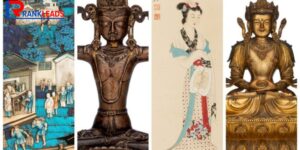The Crow Museum of Asian Art in Dallas, Texas, offers a rich and immersive experience for anyone interested in exploring the diverse cultures, traditions, and artistry of the Asian continent. A hidden gem nestled in the heart of the city, this museum is dedicated to showcasing the art and culture of Asia, featuring pieces that span thousands of years and a variety of mediums. Whether you’re an art enthusiast, a history buff, or simply looking for something unique to do in Dallas, the Crow Museum promises an enriching experience.
Introduction to the Crow Museum of Asian Art
Founded by philanthropists Trammell and Margaret Crow, the Crow Museum of Asian Art is part of the larger cultural landscape of Dallas, contributing to the city’s global appeal. Opened in 2001, the museum has grown into a well-respected institution for Asian art, education, and culture. The museum’s mission is to engage the public with high-quality, historically significant works from East and Southeast Asia, as well as Central Asia.
Located in the Dallas Arts District, one of the largest and most vibrant cultural districts in the country, the museum plays a crucial role in the city’s cultural heritage. It provides a unique opportunity to experience art from cultures that are often underrepresented in American museums, making it a vital resource for learning and appreciating Asian art and history.
A Rich Collection of Asian Art

The Crow Museum’s collection is one of the finest and most diverse in the United States, encompassing thousands of pieces that span a variety of periods, regions, and mediums. The museum’s collection includes Chinese, Japanese, Indian, Southeast Asian, and Korean art, featuring works that range from ancient sculptures and textiles to modern and contemporary pieces. It is a place where visitors can explore the evolution of Asian art, with displays that reflect both traditional and contemporary trends.
Chinese Art
The museum boasts a remarkable collection of Chinese art, which includes everything from ancient bronze vessels to contemporary sculptures. One of the standout pieces is a stunning array of Chinese jade works, including intricate carvings that date back to the Neolithic period. Jade has held significant cultural and spiritual value in Chinese society for thousands of years, and these pieces offer a glimpse into the craftsmanship and symbolism of ancient Chinese civilization.
In addition to jade, the museum features several Chinese scrolls, paintings, and ceramics. Traditional Chinese art often emphasizes themes of nature, spirituality, and harmony, and the museum’s collection reflects these values beautifully.
Japanese Art
The Japanese collection at the Crow Museum is equally impressive, with highlights including delicate Japanese prints, kimonos, and lacquerware. Japanese art is known for its meticulous attention to detail, with artists often seeking to capture fleeting moments in nature, such as the blooming of cherry blossoms or the change of the seasons.
One of the most beloved aspects of Japanese art is its connection to nature, and this is reflected in the museum’s collection of Ukiyo-e prints, which portray landscapes, kabuki actors, and beautiful women of the Edo period. The museum also showcases a wide variety of samurai armor, swords, and other objects from Japan’s feudal period.
Indian Art
Indian art has a rich and diverse history, and the Crow Museum highlights this with its collection of works from various regions and time periods. The museum’s Indian collection includes intricate sculptures of Hindu gods and goddesses, such as statues of Vishnu, Shiva, and Ganesh. These pieces provide insight into the spiritual and religious traditions of India, reflecting the deep connection between art and religion in Indian culture.
In addition to religious sculptures, the museum also features a selection of Indian textiles, such as intricately woven carpets and embroidered garments. Indian art has long been known for its vibrant colors and detailed patterns, and the museum’s collection reflects this tradition.
Southeast Asian Art
The Crow Museum also houses an exceptional collection of Southeast Asian art, including pieces from Thailand, Cambodia, and Myanmar. The museum’s Southeast Asian collection includes Buddhist sculptures, religious icons, and ceremonial objects that provide a window into the rich cultural traditions of these countries.
Southeast Asian art often blends religious symbolism with vibrant, intricate designs, and the museum’s collection of wooden and stone sculptures exemplifies this aesthetic. Visitors can explore how the region’s art evolved over time, influenced by various religious and cultural traditions, including Hinduism, Buddhism, and animism.
Korean Art

Korean art, known for its minimalist yet profound aesthetic, is another highlight of the museum. The collection includes examples of traditional Korean pottery, calligraphy, and silk painting. Korean ceramics, in particular, are highly valued for their simplicity and elegance, with an emphasis on harmony and functionality.
The Crow Museum’s Korean collection showcases the refinement and craftsmanship of Korean artisans, with pieces that span centuries of Korean history. The museum also includes contemporary Korean art, offering visitors a glimpse into the evolving trends in Korean culture and art.
Temporary Exhibitions: A Dynamic Cultural Experience
In addition to its permanent collection, the Crow Museum regularly features temporary exhibitions that provide deeper insights into various aspects of Asian culture and art. These rotating exhibits often highlight specific regions, periods, or themes, such as contemporary Asian art, the influence of Asian culture on Western art, or the intersection of art and spirituality in Asia.
Past exhibitions have included retrospectives of influential Asian artists, such as Yayoi Kusama, a Japanese artist known for her avant-garde works, and Ai Weiwei, a Chinese dissident artist whose work challenges political authority. These exhibitions provide a contemporary context for understanding the rich history and ongoing relevance of Asian art.
Educational Programs and Events
The Crow Museum is not just a space for admiring art but also a hub for learning and engagement. The museum offers a wide range of educational programs designed for people of all ages, including lectures, workshops, and hands-on activities. These programs help deepen the public’s understanding of Asian cultures, art, and history.
One of the museum’s most popular educational programs is its school outreach initiative, which brings Asian art and culture into local classrooms. Through interactive lessons and hands-on activities, students gain a greater appreciation for the art, history, and traditions of Asia.
Additionally, the Crow Museum regularly hosts cultural events such as traditional Asian festivals, performances, and film screenings. These events are designed to celebrate the diversity of Asian cultures and offer opportunities for the community to engage with different cultural traditions.
Visitor Information: Plan Your Visit
The Crow Museum of Asian Art is located at 2010 Flora Street, Dallas, Texas, within the Dallas Arts District. The museum is open to the public and offers free admission, making it accessible to everyone. It is also conveniently located near other cultural attractions in the area, such as the Dallas Museum of Art and the Nasher Sculpture Center, making it easy for visitors to explore the broader cultural landscape of Dallas.
For those planning a visit, the museum offers several amenities, including guided tours, a gift shop with unique Asian-inspired items, and a peaceful garden where visitors can reflect on the art they’ve seen. The museum’s location within the Arts District means there are also plenty of restaurants, cafes, and other attractions nearby, making it an ideal spot for a full day of cultural exploration.
Why Visit the Crow Museum of Asian Art?
The Crow Museum of Asian Art is more than just a museum; it is an immersive experience that transports visitors to a world of rich cultural traditions, captivating stories, and stunning artistic achievements.
Whether you’re eager to learn more about Asian history, appreciate traditional art forms, or discover the work of contemporary Asian artists, the Crow Museum has something for everyone.
At this museum, you can explore the lasting influence of ancient civilizations and see how their traditions continue to shape the world today. With its diverse collection, interactive programs, and focus on education, the Crow Museum of Asian Art stands as a must-visit destination for anyone seeking to explore Asia’s cultural richness.
Conclusion
The Crow Museum of Asian Art stands as a testament to the beauty, diversity, and depth of Asian cultures. Its extensive collection of art from China, Japan, India, Southeast Asia, and Korea offers a rare opportunity to experience the richness of these ancient traditions and their contemporary counterparts. As a cultural landmark in Dallas, the museum continues to educate, inspire, and engage visitors from all walks of life.
For anyone looking to immerse themselves in the artistic and cultural wonders of Asia, the Crow Museum is a must-see destination that promises an unforgettable journey through time and tradition. With its commitment to preserving and sharing the art of Asia, the museum remains an invaluable resource for understanding the history, beauty, and significance of Asian cultures.








